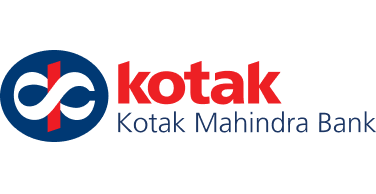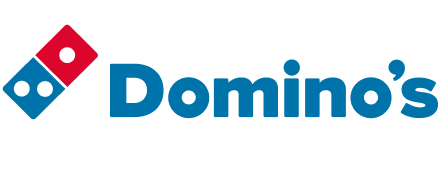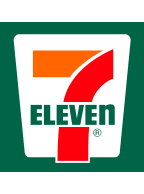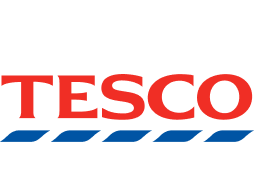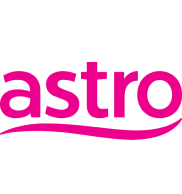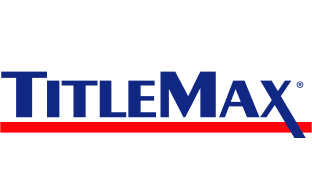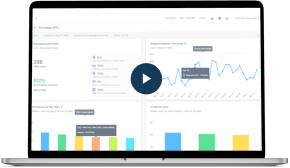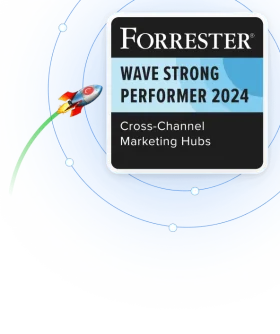The difference between marketing success and wasted budget often comes down to one critical factor: how well you understand your audience. With demographic, geographic, and psychographic segmentation, marketers can perform effective market segmentation to gain a significant advantage in creating targeted campaigns that ultimately boost sales.
This comparison guide explores these three foundational pillars of market segmentation that enable businesses to create laser-focused campaigns.
Demographic, Geographic, and Psychographic Segmentation At a Glance
Before we dive deep into each segmentation type, let’s take a bird’s eye view of how demographic, geographic, and psychographic segmentation compare:
| Criteria | Demographic Segmentation | Geographic Segmentation | Psychographic Segmentation |
| Definition | Divides market based on measurable population characteristics | Segments market by physical location | Categorizes consumers based on psychological attributes |
| Key Variables | Age, gender, income, education, occupation | Country, region, city, climate, population density | Lifestyle, values, interests, attitudes, personality traits |
| Data Collection | Relatively easy through surveys, census data | Straightforward, using geographic information systems | More complex, often requiring in-depth research |
| Application | Product development, broad marketing strategies | Localized marketing, distribution planning | Personalized messaging, brand positioning |
| Limitations | Doesn’t account for individual preferences | May overlook individual differences within regions | Can be subjective and change over time |
This table provides a quick reference for marketers to understand the key differences between demographic, geographic, and psychographic segmentation. Each approach offers unique insights and applications, which we’ll explore in more detail throughout this article.
Deep Dive: Demographics, Geographics, Psychographics Explained
Now that we have an overview, let’s delve deeper into each segmentation type, exploring their focus areas, key variables, and specific purposes in marketing strategy.
Demographic Segmentation
Demographic segmentation helps marketers identify broad market segments with similar characteristics. This approach is particularly useful for products or services that cater to specific life stages or income brackets.
Key Variables:
- Age
- Gender
- Income
- Education level
- Occupation
- Family size
- Marital status
- Ethnicity
Geographic Segmentation
Geographic segmentation allows marketers to tailor their strategies to specific locations, considering factors like local preferences, weather patterns, and cultural nuances.
Key Variables:
- Country
- Region
- State/Province
- City
- Neighborhood
- Climate
- Population density
- Urban/Suburban/Rural classification
Psychographic Segmentation
Psychographic segmentation delves into the psychological aspects of consumer behavior, offering a deeper understanding of motivations and preferences.
Key Variables:
- Lifestyle
- Personality traits
- Values
- Attitudes
- Interests
- Opinions
- Social class
The interplay between demographics, geographics, psychographics provides a comprehensive view of consumer behavior, allowing for more nuanced and effective marketing strategies.
Benefits of Demographic, Geographic, and Psychographic Segmentation
Each segmentation approach offers unique advantages to marketers. Let’s explore the benefits of geographic, demographic, and psychographic segmentation in detail.
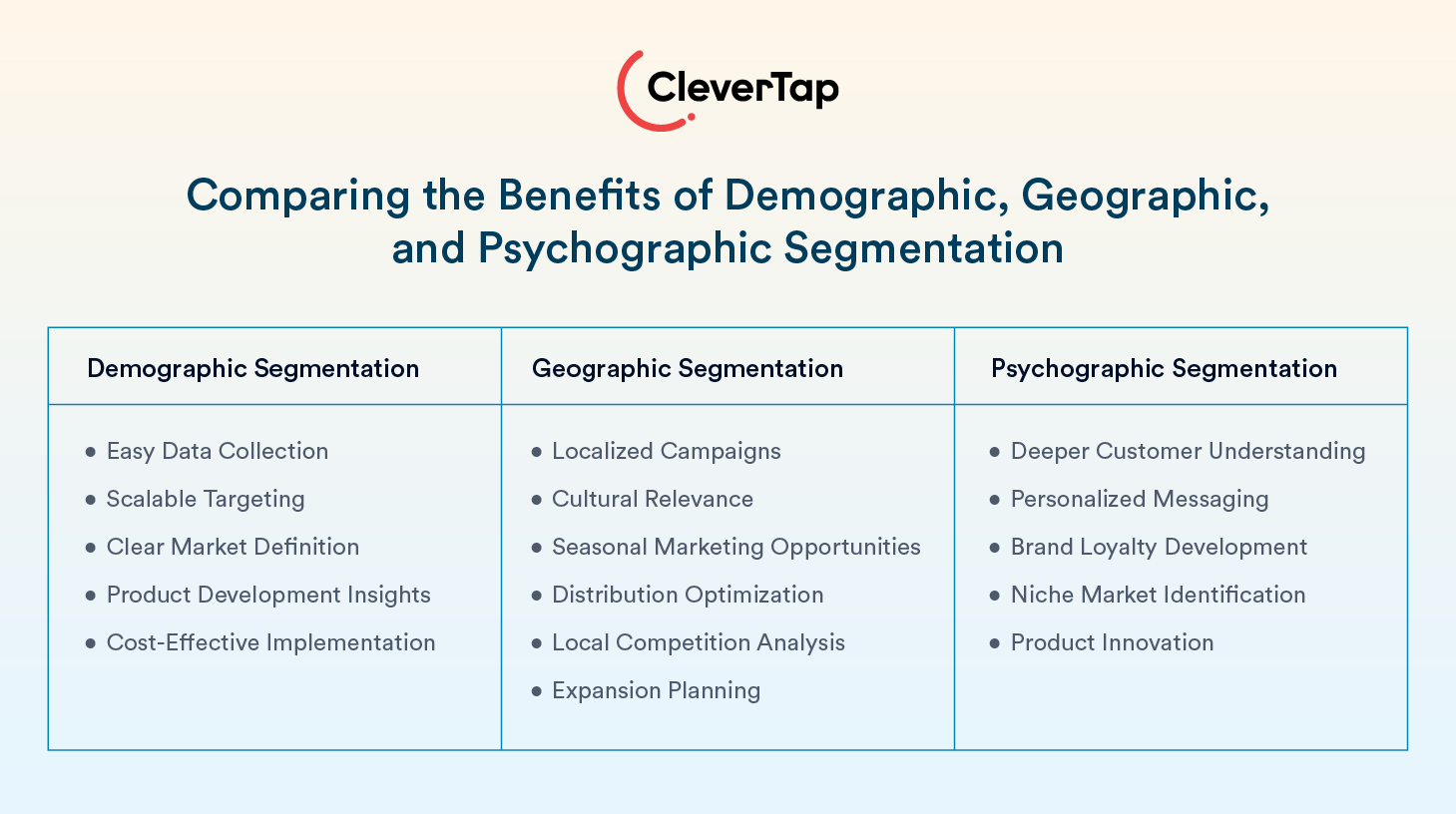
Benefits of Demographic Segmentation
Easy Data Collection: Customer demographic information flows from multiple reliable sources. Census bureaus provide population-wide statistics, while CRM systems capture valuable user data. This accessibility means marketers can quickly assemble comprehensive demographic profiles without specialized research tools or expertise.
Scalable Targeting: The quantifiable nature of demographic variables allows marketers to identify and target large population segments efficiently. A single campaign can reach millions of consumers who share key characteristics like age range or income bracket, maximizing reach while maintaining relevance.
Clear Market Definition: Demographic segmentation creates concrete, measurable boundaries around market segments. This clarity helps organizations communicate target audiences precisely across departments, ensuring product teams, marketers, and executives share a common understanding of who their customers are.
Product Development Insights: Demographics directly inform product features, pricing strategies, and positioning. Understanding family structures helps design appropriate product sizes, while income data guides pricing tiers that balance accessibility with profitability.
Cost-Effective Implementation: The straightforward nature of demographic segmentation requires minimal specialized analytics or research investment, making it accessible even for organizations with limited marketing budgets.
Benefits of Geographic Segmentation
Localized Campaigns: Geographic insights enable messaging that acknowledges regional realities, significantly increasing relevance. Advertisements featuring local landmarks or references create immediate connection and recognition.
Cultural Relevance: Beyond physical location, geographic segmentation captures cultural variations. Understanding these nuances helps brands avoid cultural missteps while embracing regional preferences that resonate with local consumers.
Seasonal Marketing Opportunities: Climate and seasonal patterns vary dramatically by location, creating natural opportunities for regionally-timed promotions. Winter clothing campaigns can launch months earlier in northern regions while coastal areas might receive extended summer promotions.
Distribution Optimization: Geographic data directly informs physical distribution strategies, helping businesses locate warehouses and retail outlets strategically to minimize costs while maximizing accessibility.
Local Competition Analysis: Regional market dynamics often differ substantially, with varying competitive landscapes requiring tailored approaches and location-based marketing. Geographic segmentation identifies areas where competition is sparse, revealing untapped opportunities.
Expansion Planning: Systematic geographic analysis reveals promising new markets with similar characteristics to current successful territories, providing a roadmap for strategic expansion.
Benefits of Psychographic Segmentation
Deeper Customer Understanding: Psychographic insights reveal the motivational drivers behind purchasing decisions, explaining why consumers choose certain products over others. This deeper understanding transforms customers from statistics into multidimensional individuals.
Personalized Messaging: Knowledge of values and aspirations enables emotionally resonant communication that cuts through marketing clutter, capturing attention in ways demographic targeting alone cannot achieve.
Brand Loyalty Development: When brands demonstrate an understanding of consumers’ deeper values, the relationship transcends transactions. Consumers become loyal advocates when they feel a brand authentically shares and supports their core beliefs.
Niche Market Identification: Psychographic segmentation uncovers specialized market segments united by common interests or viewpoints rather than traditional demographics, revealing lucrative opportunities in previously overlooked areas.
Product Innovation: Understanding psychological motivations inspires truly innovative solutions that address unmet emotional and lifestyle needs rather than simply iterating on existing product categories.
By leveraging the strengths of each segmentation type, marketers can create more targeted, relevant, and effective marketing strategies.
Limitations of Demographic, Geographic, and Psychographic Segmentation
While segmentation is a powerful tool, it’s important to understand its limitations. Let’s examine the potential drawbacks of geographic, psychographic, and demographic segmentation.
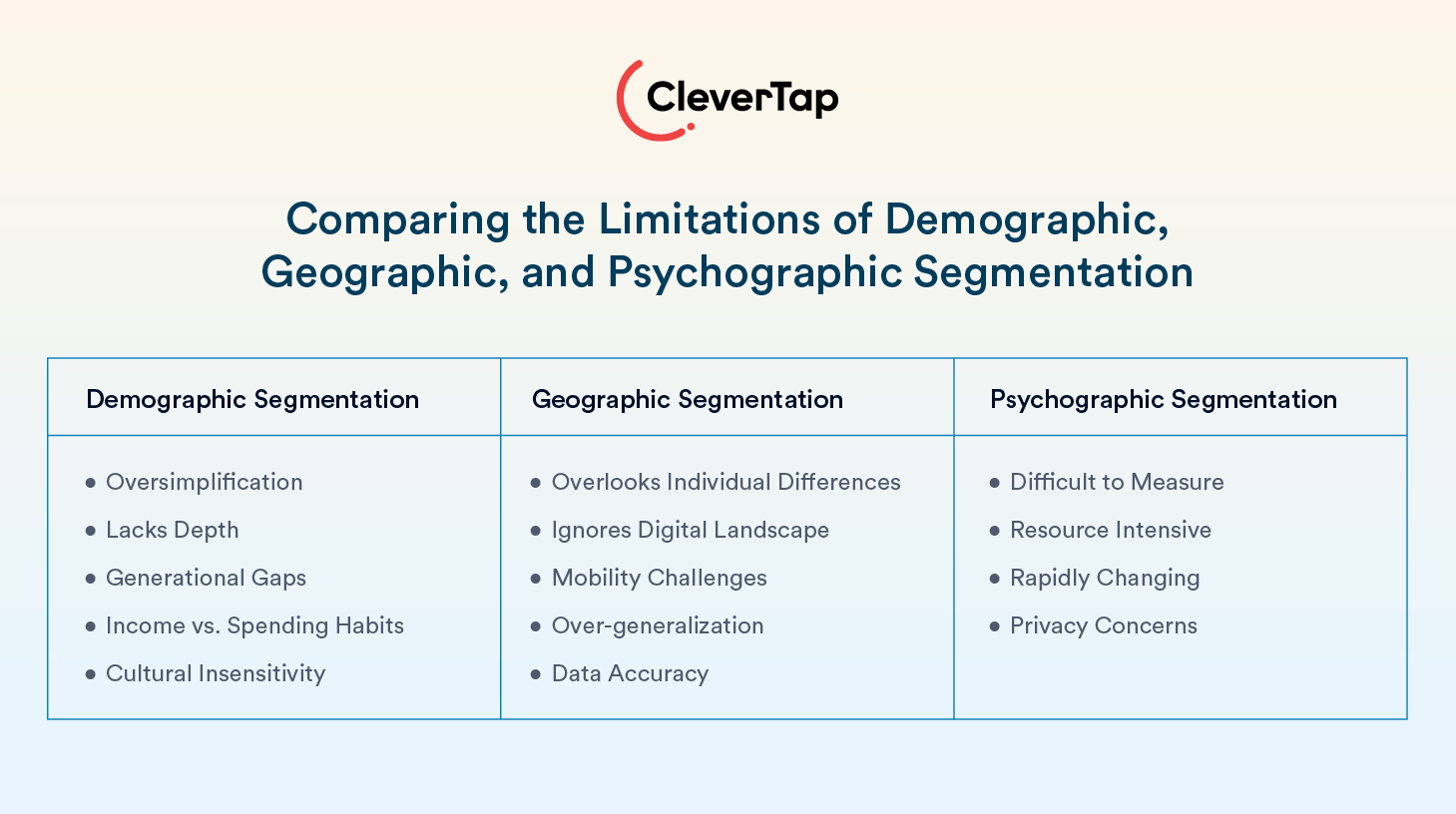
Limitations of Demographic Segmentation
Oversimplification: Demographic segmentation reduces complex individuals to a handful of quantifiable characteristics, creating an illusion of understanding while potentially missing critical differentiators. Two consumers with identical demographic profiles might have different preferences, priorities, and purchasing behaviors that demographic categories simply cannot capture.
Lacks Depth: While demographic data answers “who” questions effectively, it fails to address the crucial “why” behind consumer decisions. Complex psychological factors, including personal values, emotional needs, and aspirational identity, drive purchasing behaviors, requiring needs-based segmentation.
Generational Gaps: Traditional demographic categories struggle to account for evolving societal norms. Life stage markers like marriage, homeownership, and parenting occur at increasingly varied ages, making age-based assumptions increasingly unreliable. Many consumers now defy conventional demographic expectations.
Income vs. Spending Habits: Income levels often correlate poorly with actual spending behavior. High-income consumers may be surprisingly frugal in certain categories, while moderate-income individuals might prioritize spending in areas that align with their passions or social identity.
Cultural Insensitivity: When applied without cultural context, demographic segmentation can perpetuate stereotypes and miss important cultural nuances. Ethnic categories encompass tremendous diversity that simple demographic classifications often obscure, potentially leading to tone-deaf marketing.
Limitations of Geographic Segmentation
Overlooks Individual Differences: Geographic segmentation assumes proximity creates similarity. While people in the same region may share some characteristics, this approach can blind marketers to significant variations in preferences within any geographic area. A luxury brand might target an affluent suburb but miss that households have vastly different spending priorities and brand affinities.
Ignores Digital Landscape: As digital commerce reshapes consumer behavior, physical location becomes increasingly disconnected from purchasing patterns. Online shoppers routinely purchase from businesses continents away, making regional boundaries less relevant for digital products and easily shippable goods. Geographic targeting creates artificial constraints in a borderless digital marketplace.
Mobility Challenges: Modern lifestyles involve significant mobility that geographic segmentation struggles to capture. Business travelers, digital nomads, and commuters frequently make purchasing decisions outside their home regions, creating disconnects between where consumers are categorized and where they engage with brands.
Over-generalization: Geographic segmentation can promote regional stereotyping, leading to tone-deaf marketing. Assuming everyone in a region shares identical preferences oversimplifies complex cultural landscapes and can alienate consumers who don’t fit these profiles.
Data Accuracy: Geographic information requires constant maintenance. Population shifts, gentrification, and infrastructure development reshape geographic realities. Without updates, geographic segmentation can become outdated, directing resources toward areas that no longer match their historical profiles.
Limitations of Psychographic Segmentation
Difficult to Measure: Unlike concrete demographic factors, psychographic variables like values, attitudes, and lifestyle preferences exist primarily in consumers’ minds, making them inherently challenging to quantify accurately. Survey responses may reflect aspirational rather than actual beliefs, and observed behaviors might contradict stated values, creating significant measurement challenges.
Resource Intensive: Gathering meaningful psychographic insights requires sophisticated research methodologies including in-depth interviews, extensive surveys, and observational studies. This research demands significant time, expertise, and financial investment, making thorough psychographic segmentation inaccessible for many smaller organizations.
Rapidly Changing: Psychological attributes and cultural trends evolve continuously, sometimes shifting dramatically in response to external events. The COVID-19 pandemic transformed lifestyle preferences and priorities for millions of consumers. This volatility means psychographic insights can have a shorter shelf life than more stable demographic or geographic data.
Privacy Concerns: Collecting psychographic data often involves tracking online behaviors, social media activity, and personal preferences, raising significant privacy concerns. As consumers become more protective of their data and regulations like GDPR restrict data collection practices, obtaining comprehensive psychographic insights grows increasingly challenging.
Understanding these limitations is crucial for marketers. It highlights the importance of using a combination of segmentation approaches to create a more accurate and nuanced understanding of the target market.
How to Choose the Right Segmentation Strategy
Selecting the optimal segmentation approach requires strategic consideration of your specific business context and goals. This decision framework will guide you toward the most effective segmentation strategy.
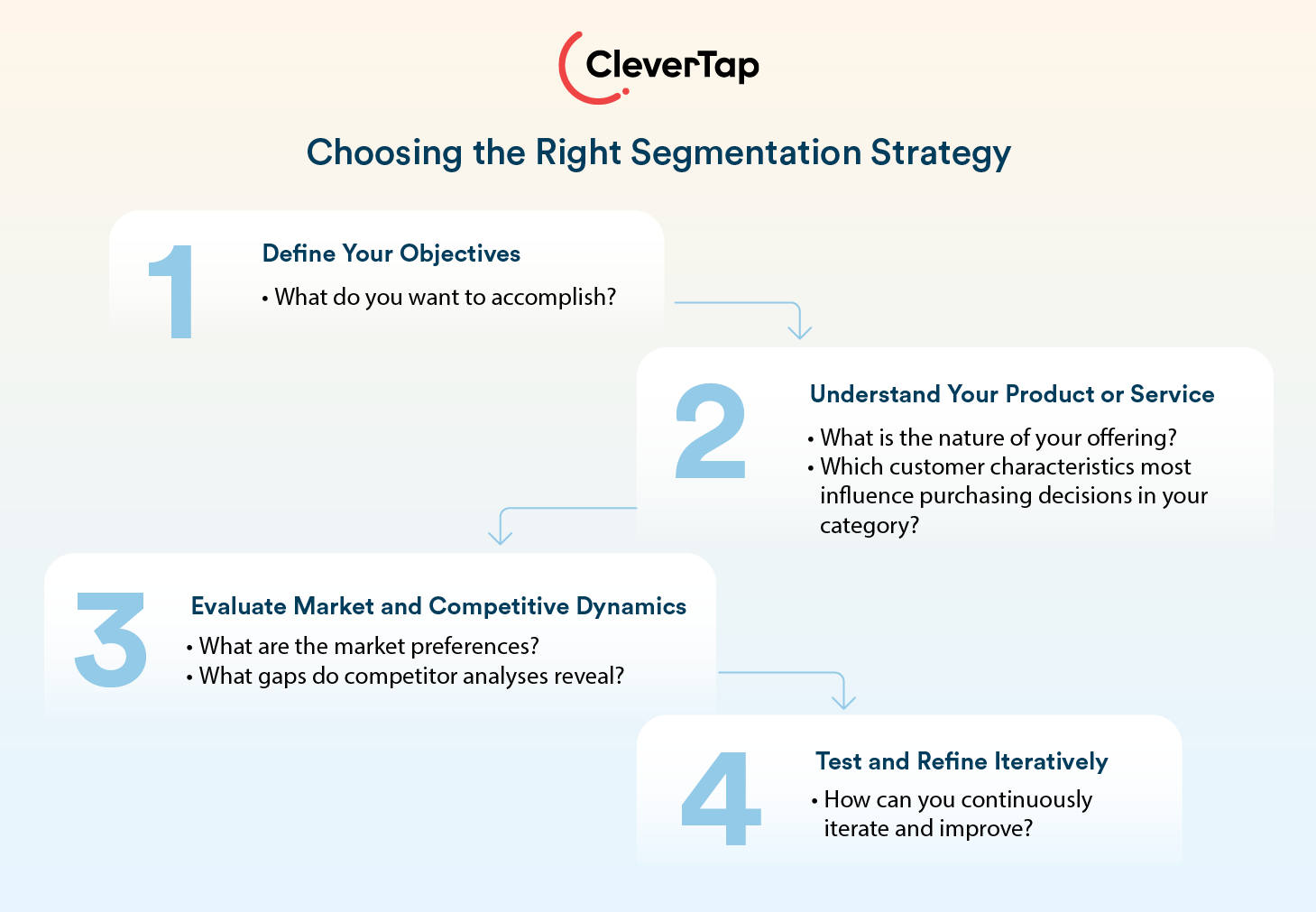
Define Your Objectives
Begin with clarity about what you need segmentation to accomplish. A product launch requires identifying primary demographic targets, while message refinement benefits from psychographic insights into consumer motivations. Expansion planning naturally gravitates toward geographic approaches.
Understand Your Product or Service
Your offering’s nature provides natural segmentation guidance. Location-dependent services demand geographic approaches. Life-stage products align with demographic segmentation. Products connected to identity or values require psychographic insights. Consider which customer characteristics most influence purchasing decisions in your category.
Evaluate Market and Competitive Dynamics
Markets with strong regional preferences naturally suit geographic segmentation. Diverse markets benefit from multiple segmentation layers. Competitor analysis reveals both conventional approaches to consider and potential gaps representing unexplored segmentation opportunities.
Test and Refine Iteratively
Begin with the most accessible approach based on your current data and resources. Test this preliminary segmentation through targeted initiatives, measuring response rates across segments. Use results to refine your model, gradually incorporating additional variables that address understanding gaps.
How Demographic, Geographic, and Psychographic Data Are Integrated for Effective Marketing
Integrating these approaches can lead to more nuanced and effective marketing strategies. Here’s how to combine these methods for maximum impact:
Creating Living, Breathing Customer Profiles
When you integrate all three segmentation approaches, generic customer profiles become vivid representations of real people.
Consider how different “millennial female professionals” become when you add layers of geographic context (urban Chicago vs. suburban Phoenix) and psychographic depth (sustainability-focused minimalist vs. luxury-aspiring status seeker).
Suddenly, you’re not marketing to a demographic statistic but to “Emma,” whose specific lifestyle, values, and location inform everything from product features to messaging tone.
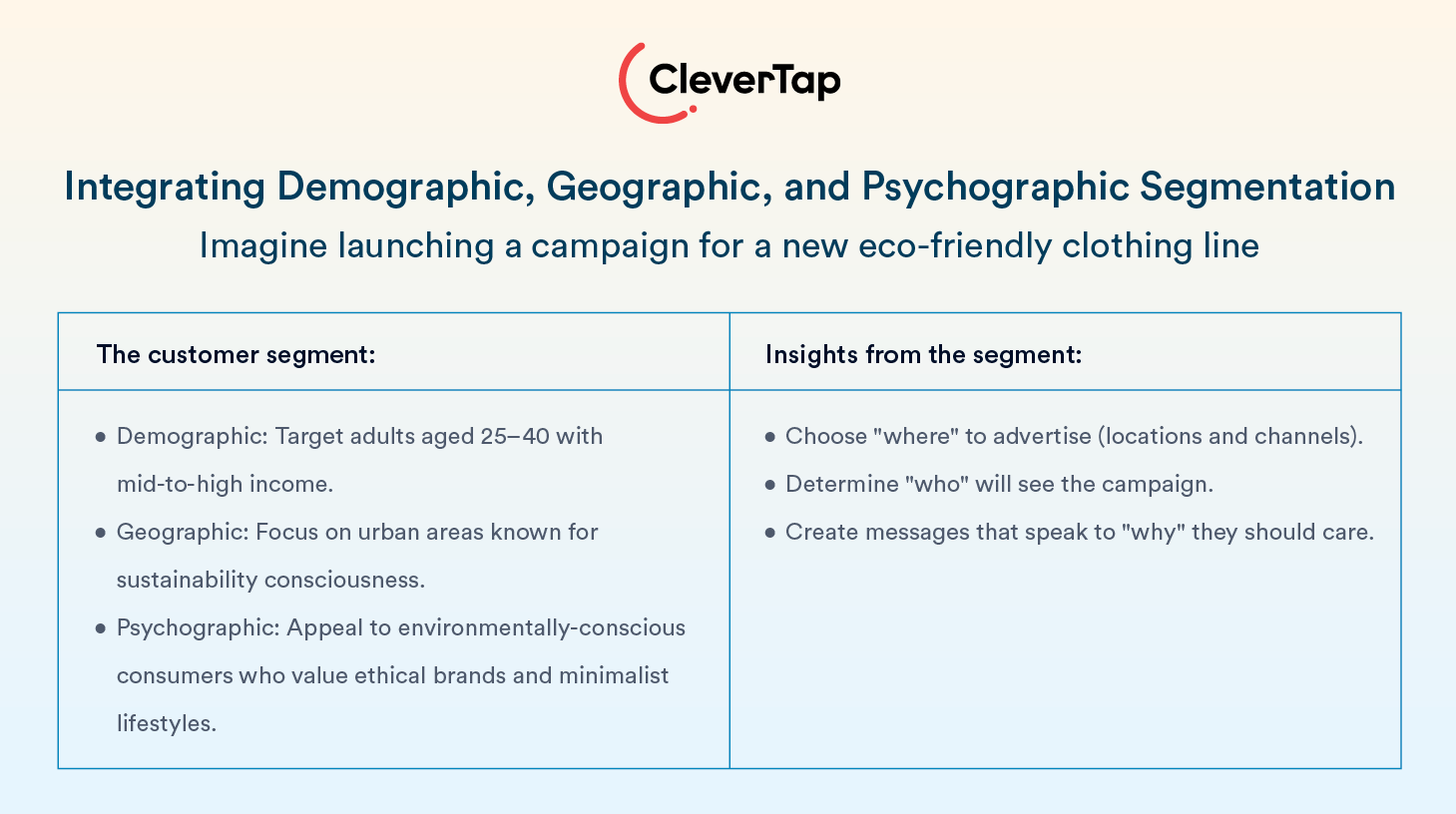
Imagine launching a campaign for a new eco-friendly clothing line:
- Demographic: Target adults aged 25–40 with mid-to-high income.
- Geographic: Focus on urban areas known for sustainability consciousness (e.g., Portland, Amsterdam).
- Psychographic: Appeal to environmentally-conscious consumers who value ethical brands and minimalist lifestyles.
Together, this combo allows you to:
- Choose “where” to advertise (locations and channels).
- Determine “who” will see the campaign.
- Create messages that speak to “why” they should care (e.g., “Look good, feel good, and do good for the planet”).
Real-World Integration Success Stories
Here are some real-world examples from brands that successfully integrated demographic, geographic, and psychographic segmentation.
1. MX Player
MX Player’s segmentation strategy combines geographic, demographic, and psychographic insights to deliver truly personalized content. By layering location data with language preferences and viewing history, they ensure that urban viewers might see original‑language Hollywood action films, while audiences in regional markets receive dubbed romantic dramas in their native tongue.
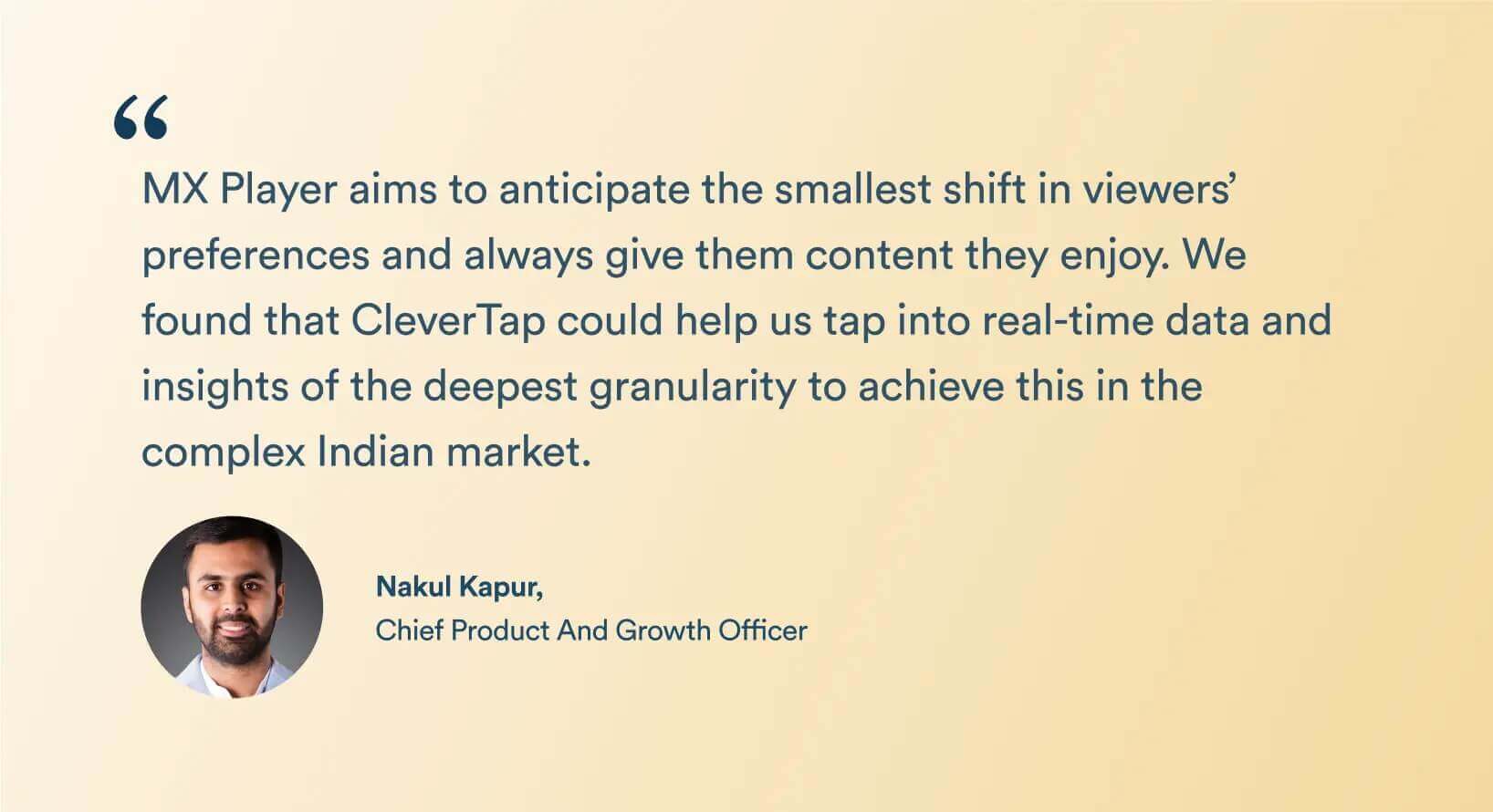
This strategy helped MX Player achieve a 39% rise in viewership and a 70% boost in CTRs.This granular approach shapes everything from homepage recommendations to push notifications, making each content suggestion feel culturally relevant and uniquely tailored to individual tastes.
Read the full case study here.
2. Nike
Nike’s neighborhood-specific stores highlight the benefits of precise segmentation. Their SoHo NYC location doesn’t just acknowledge geographic location—it incorporates a psychographic understanding of urban running culture and demographic knowledge of local income levels and age distribution. This integration manifests in everything from inventory selection to store design to community events.
3. Whole Foods
Whole Foods tailors its product selection based on integrated segmentation data. Their stores in affluent, environmentally-conscious Boulder feature different product mixes than locations in family-oriented suburban areas, even though the demographic income profiles might appear similar.
Practical Implementation Steps
Begin by building integrated data collection systems that capture all three dimension types simultaneously. Customer surveys should incorporate geographic identifiers alongside demographic and psychographic questions. Digital analytics should track not just demographic visitor profiles but also regional patterns and content preferences that reveal psychographic insights.
Then, implement testing frameworks that measure the effectiveness of integrated approaches against single-dimension strategies. This validation helps overcome organizational resistance to more complex customer segmentation models by demonstrating their superior ROI.
The integration of these three segmentation dimensions improves marketing efficiency and your ability to connect with customers as complete human beings rather than simplified data points.
How CleverTap Enhances Demographic, Geographic, and Psychographic Segmentation for Effective Marketing
CleverTap, as an all-in-one customer engagement platform, enables businesses to use this integration for precise personalization, higher conversions, and improved customer retention.
Here’s how CleverTap supports key use cases:
1. Create Multi-Dimensional Personas
CleverTap’s customer segmentation tool enables brands to build detailed customer personas by combining demographic, psychographic, and geographic data. With TesseractDB™, businesses can store unlimited data points per user over a 10-year lookback period, allowing for deeper insights into customer behaviors and preferences.
CleverTap’s AI-driven segmentation helps marketers automatically assign such users to highly relevant audience groups.
2. Build Precise Segments—No Code or SQL Required
Using advanced “if/else” conditions and dynamic segmentation logic, CleverTap lets you create precise and accurate segments across multiple dimensions. Whether you’re segmenting based on demographics, psychographics, or geography, the platform’s powerful rules engine ensures that each segment reflects nuanced user behavior and characteristics.
3. Personalize Customer Experiences
By leveraging demographic, psychographic, and geographic segmentation together, CleverTap lets you personalize the what, when, and how of every customer interaction—ensuring your message, its timing, and its channel are uniquely tailored to each user.
- What (Content): Segment by age, gender, interests, or location to serve the most relevant offers, imagery, and messaging. For example, a fashion retailer can automatically swap product visuals and copy for urban millennial women versus suburban family shoppers—all within the same campaign template.
- When (Timing): Deliver messages when each segment is most receptive. Whether that’s evening browsing sessions in Mumbai or lunchtime breaks in London, campaigns fire precisely when users are likely to engage.
- How (Channel): Automatically route outreach through each user’s preferred channel—push notifications, in‑app messages, email, WhatsApp, or SMS—based on psychographic channel affinity and geographic connectivity. High‑value RFM segments might receive priority push alerts, while sporadic browsers are nurtured via email or WhatsApp.
4. Enhance Advance Segmentation
You can blend traditional demographic (age, gender, income), psychographic (lifestyle, values, interests), and geographic (country, region, city, radius) filters with more advanced segmentation engines—Past Behavior, Live Action, Predictive/Intent‑Based, and RFM—to build infinitely precise audience groups.
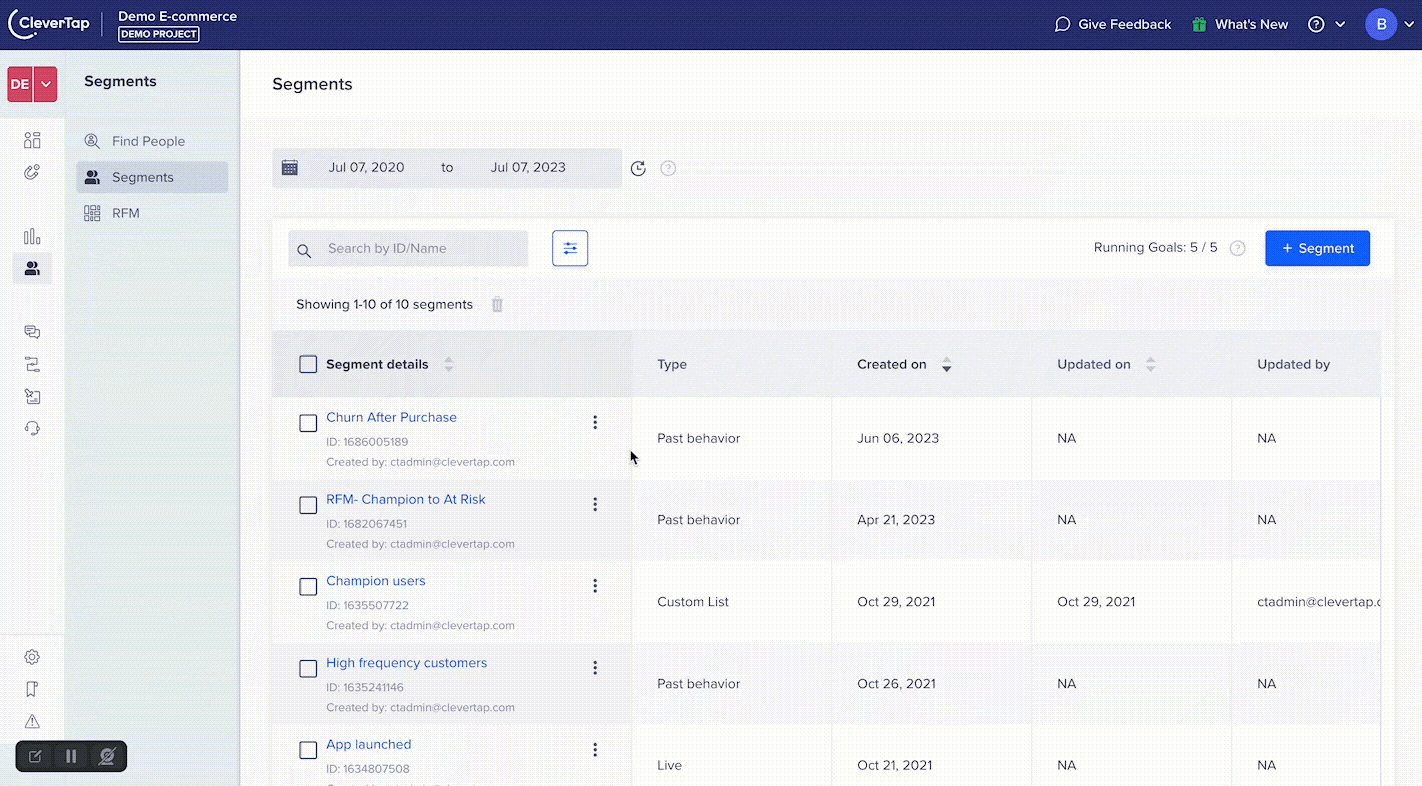
Past Behavior Segments let you define cohorts based on any combination of historic actions, inactions, and profile properties over a customizable lookback window.
Live Action Segments capture users in real time the moment they perform—or fail to perform—key events (e.g., add to cart but don’t purchase within 10 minutes).
Predictive/Intent‑Based Segments use machine learning to forecast which users are Most, Moderately, or Least Likely to convert, churn, or achieve any goal—complete with a built‑in 5% control group for lift measurement.
RFM Segments automatically group users by Recency, Frequency, and Monetary spend to identify Champions, At‑Risk, and Dormant users for tailored retention or upsell strategies.
With CleverTap, you start by casting a wide net with demographic, geographic, and psychographic filters.
Then layer the more advanced segmentation capabilities, resulting in micro‑segments like “urban Mumbai millennials passionate about sustainability who streamed eco‑documentaries, abandoned a cart, and have a high purchase intent score.”
CleverTap helps you gain deep business insights—pinpointing your most profitable audiences, measuring incremental lift with built‑in control groups, and delivering hyper‑personalized campaigns that drive real growth in engagement, retention, and revenue.
5. Improve Customer Journey Mapping
CleverTap’s Lifecycle Optimizer and Journey Builder go far beyond simple demographic, psychographic, and geographic filters—transforming those broad attributes into real‑time, behavior‑driven customer journeys that deliver measurable business impact.
Lifecycle Optimizer stitches together your full history (using user status segmentation) into dynamic, stage‑based segments—new, active, dormant, at‑risk, and churned. By layering on demographic, geographic, and psychographic properties, you instantly identify exactly where users drop off and what nudges they need next.
Similarly Journeys take that insight and automates omnichannel campaigns: trigger an different onboarding tutorial when a new male user in Mumbai first opens the app; deliver a discount via push to a high‑value user who abandoned their cart within 10 minutes; send an email tailored to a user’s preferences to a “moderately likely to convert” segment predicted by CleverTap’s AI and so on.
This unified approach uncovers drop‑off touchpoints and automatically triggers the right campaign at the right moment. The result is hyper‑personalized, omnichannel customer experiences that boost activation, retention, and revenue.
6. Refine Targeting in Digital Advertising
With CleverTap’s real‑time segmentation, you can build ultra‑targeted audiences and activate them across every major paid channel—Google Ads Remarketing, Facebook Audience Network, and TikTok Remarketing. This enables you to:
- Create lookalike audiences by exporting any CleverTap segment directly into Google Ads or Facebook for high‑precision prospecting
- Retarget engaged but non‑converting users with dynamic product ads on Google Search, YouTube, Instagram, or TikTok to recover lost revenue
- Optimize ad frequency and budget allocation by segment, ensuring you spend efficiently and avoid oversaturating high‑value users
CleverTap ensures your digital advertising campaigns reach the right people, in the right place, at the right time—driving measurable lift in conversions and ROI.
Segment Better to Target Better
The most effective marketing strategies often combine demographic, geographic, and psychographic data to develop highly targeted campaigns, personalize customer experiences, and make informed product development and market expansion decisions.
However, segmentation is not a one-time task but an ongoing process. Consumer behaviors and market dynamics are constantly changing, requiring marketers to reassess and refine their segmentation strategies regularly.
Kiran Pius 
Leads Product Launches, Adoption, & Evangelism.Expert in cross-channel marketing strategies & platforms.
Free Customer Engagement Guides
Join our newsletter for actionable tips and proven strategies to grow your business and engage your customers.








